
21 minute read
CPD: Gender & The Lower Face
Gender & The Lower Face
Dr Eleanor Reid, Miss Lara Watson and Miss Priyanka Chadha explore the gender differences in the lower facial third and discuss treatment considerations
Advertisement
Trends published in the press and social media, as well as our own combined clinical experience, suggest that the demand for treatment of the lower facial third has become increasingly popular in recent years for both male and female patients. When planning treatment, gender differences with regards to the anatomy, histology of the hard and soft tissues, surface contours and soft tissue features should be considered, as well as how these evolve through the distinctive male and female patterns of ageing.
Anatomical differences in males and female In the developmental stages, all faces phenotypically start ‘female’, regardless of biological gender. Approaching adulthood, however, the male face forms a more masculine appearance through changes driven by testosterone, including adaptations in skeletal shape, subcutaneous fat distribution and cutaneous physiology.1,2 The facial height to width ratio gives the overall facial type – the proportion of which in males is typically 1.35:1 and 1.31:1 in females.3 The vertical facial thirds are typically equal in women, however in men, the anterior lower facial height is often slightly greater than the middle third.3
Bone At a bony level, the Caucasian female facial skeleton is more oval and v-shaped, compared to the male skeleton, which is typically more angular and square in formation. The male mandible has a more prominent flexure, resulting in a stronger, wider and more anteriorly projected chin, a more defined jawline with greater definition at the ramus and angle of mandible.4 In one study, orthopantomographs of 2,699 individuals were analysed, which demonstrated the average gonial angle (angle of the mandible) in female participants to be significantly larger than that of male participants (P<0.0002). Additionally, ramus height and bigonial width were shown to be greater in males compared to females (P<0.0001).5
Histological The skin plays a key role in the perception of beauty and wellness. Knowledge of the physiological and chemical differences between male and female skin can help practitioners devise tailored treatment plans to deliver optimal cosmetic results. Studies have shown that male skin comprises larger pores and produces more sebum, making it more prone to congestion, the formation of pustules (spots) and the development of acne at a pre-adolescent age.6-9 In post adolescent groups, clinical acne is, however, more prevalent in females; oppose to physiological variables in skin this may be related to the use of low-dose oral contraceptives.10 Furthermore, skin pigmentation and cross-sectional thickness are significantly higher in men.6 Male skin naturally has a high collagen content and demonstrates higher levels of lactic acid production.7 At the subcutaneous level, female skin is shown to contain higher relative quantities of adipose tissue.11
Muscle With regards to the facial musculature, men and women differ in terms of both anatomical size and dynamic function (movement). It is well documented that female muscle bulk, including that of the facial musculature, is significantly lower than in men.4,12 In the lower third, for instance, this is demonstrated in the masseter muscles, where the mean thickness in females is reported as 13mm +/- 1.8mm and in males it is 15.1mm +/- 1.9mm.13 The kinetic energy generated by these muscles is comparably greater in men than in women, resulting in larger movements of surface features and dimensionally greater facial expressions. These differences have an impact upon the formation of rhytides (wrinkles) and the gender-specific patterns that can occur.4 In one study of 173 Japanese men and women, measures of wrinkle formation and severity using 3D analysis techniques were found to be significantly greater in men compared with women for most sites including the nasolabial groove and mouth corner.14
Soft tissue features When considering the soft tissues of the lower face, anatomical studies have shown that the female chin and jaws are narrower and less prominent compared to that of the male.1,2,15 Assessment of the female face in profile shows that the chin sits slightly posterior to the lower lip, whereas in men they are in line.1,2 A deeper labiomental groove is observed in men, typically measuring 6mm compared to the average 4mm seen in women. The literature also reports that men tend to have larger mouths (intercommissural distance), but smaller lips (particularly the upper lip) with wider and thicker philtral columns.1,11
Ageing of the face in the lower third It is clear that unique patterns of ageing occur in men and women at every histological level, including the skin, subcutaneous tissues, muscle layer and bone. Practitioners should be aware of the distinct characteristics of gender-specific ageing in order to deliver effective and appropriate treatment. While men experience gradual and progressive reductions in testosterone production with age, women demonstrate abrupt declines in oestrogen production around the time of menopause in the fifth decade of life.16,17 With age, men can lose the masculine features of the lower third with reduction in the overall bony dimensions of the mandible (jawbone) through skeletal resorption, loss of the angular shape and definition of the jawline and sagging of the overlying skin to create pre-jowls.4 On the contrary, women complain of the face becoming masculinised and adopting the typical male ‘square’ shaped lower
face. This occurs through a loss of relative width in the mid-face, gravitational descent of soft tissues, progressive laxity of the retaining ligaments and dentoalveolar resorption.4,5 Computerised tomography (CT) scans such as those described by Mendelson and Wong show clear radiographic evidence that the facial skeleton undergoes selective resorption with age.18 Both male and female mandibles show no change in the bigonial width and breadth of the ramus; however, with age, the height of the ramus and mandibular body decrease and the mandibular angle increases. The result creates a more obtuse mandibular angle and retraction of the chin. This occurs even with the presence of a full dentition, although tooth loss significantly accelerates maxillary and mandibular resorption.15,18 Ageing at the bony level has a subsequent effect on the overlying soft tissues in the lower face region. In this area, the lack of bony projection creates a relative concavity and contributes to the presence of jowls.18 It is well reported that age changes in the mid-face have an effect on the lower third. Major loss of the bony projection of the maxilla, which contributes to the edge of the pyriform aperture, results in the undermining of structural support to the alar base and upper lip, resulting in the development of nasolabial folds (amongst other lower facial folds) in both sexes.4,18 At a skin level, facial ageing can be more apparent in women than men. Due to a higher level of adipose tissue at the subcutaneous level, women are more likely to develop fine surface lines, opposed to the deeper rhytides seen in men.11 Deeper lines in men are also attributed to a greater skin thickness. Higher rates of sebum and lactic acid production, however, assist in the lubrication of the stratum corneum, aiding natural moisturisation of the male skin and making it less prone to surface dryness.11 In terms of the dynamism of the lower face, men have a greater upward vertical movement of the facial muscles when puckering the lips and smiling, which should be considered to select a product of appropriate rheology. Both men and women can be prone to masseteric hypertrophy through bruxism and other parafunctional habits, but the resulting cosmetic impact of this is distinctively different between the sexes; masculinising the female face and creating an irregular contour and aggressive appearance in the male face.4 In youth, men tend to have deeper rhytids in the perioral region than women of the corresponding age due to the differences in dynamic movement and gender specific skin characteristics discussed above. In the ageing face, however, this region is the one exception to where older women develop deeper rhytides than men.4,11 Across both sexes, thinning of the lips and blunting of the vermillion border and philtral columns are observed.4 Lower face ideals: male vs. female Although the perception of beauty and facial ideals are very much subjective to societal trends and individual opinion, the physical attributes that are conventionally considered ‘attractive’ differ between the sexes. Features that contribute to an overall aesthetic appearance are variable from one race to another; however, consideration should be made that the norms of any population should be considered as
In youth, men tend to have deeper rhytids in the perioral region than women of the corresponding age due to the differences in dynamic movement and gender specific skin characteristics a guide and not an absolute value, which may vary depending upon age, gender and ethnicity. Furthermore, the practitioner should never make assumptions as to what the patient’s treatment goals are based on their sex or any other demographic measure. In women, facial attractiveness is mostly attributed to the cheekbones and prominent upper facial features. The ‘inverted triangle of youth’ that describes a gradual taper in the facial contour from upper to lower is considered a feminine feature of youth across all ethnicities.1,2,4 A chin width that is equal to the flare of the nostrils that descends into an apex and sits at or just posterior to the Riedel line – a line connecting the most anterior point of the upper lip, lower lip and chin in a balanced face – is perceived as a feminine facial appearance.19 This also denotes where the maximum lip volume should be concentrated. In Caucasian women, traditional ‘golden ratio’ of upper to lower lip is 1:1.6; however, a shift in recent trends tends to favour the 1:1 ratio.19 Alternatively, male attractiveness is mostly attributed to the masculine appearance that can be created with a strong jawline and chin.1,2,20 In men, the ideal facial shape has a chin width that corresponds to the width of the mouth. It is flatter and more projected with two squaredoff tubercles.2,4 Emphasis is also placed on the lateral flare of the mandible, with the maximum width of the lateral projection of the zygomas equalling the lateral flare of the mandibular angle, in order to create an equally balanced middle and lower third that creates the ideal ‘square’ male facial shape.11 In profile, both upper and lower lip should project anteriorly to satisfy the Riedel line.4 Before After
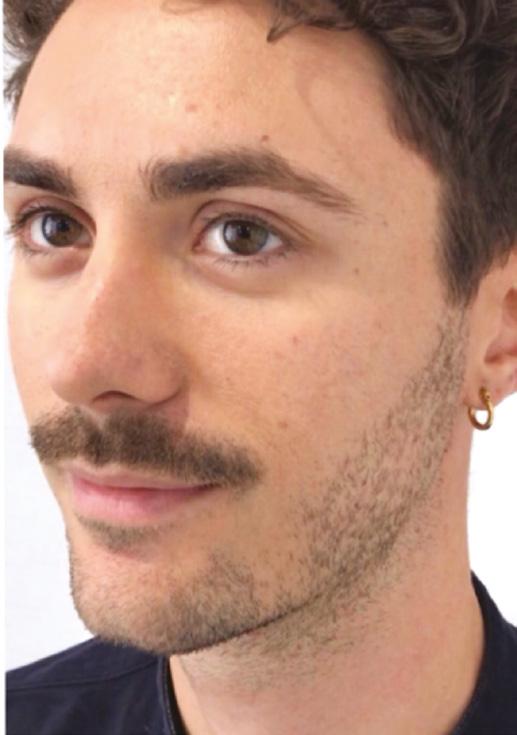
Figure 1: Pre- and post-treatment photographs of a male patient receiving chin and jawline augmentation. Pre-treatment photograph demonstrates poorly defined mandibular angle and a rounded chin. A total of 4ml of Restylane Volyme was used to increase width of the lower third and enhance the definition of the jawline.
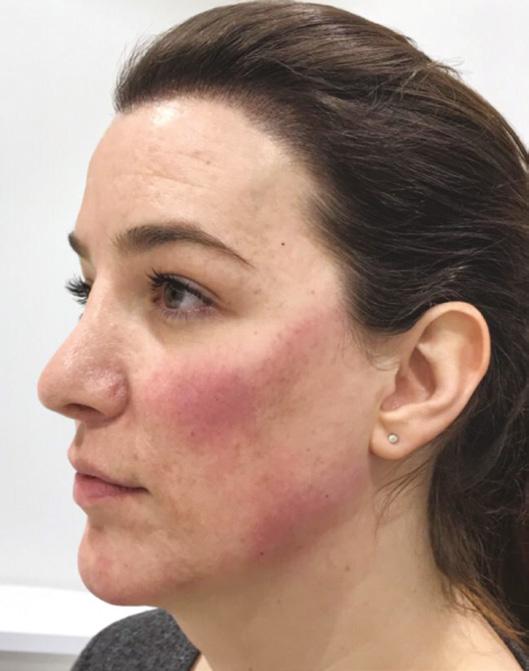
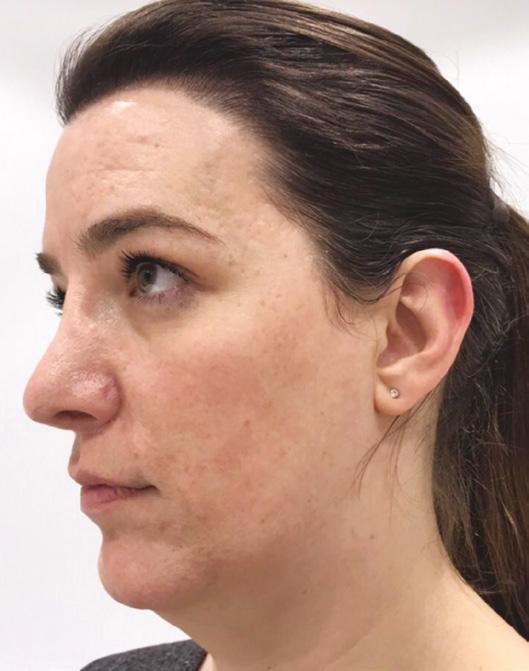
Before Before
Figure 2: Pre-treatment photographs demonstrating a mild-moderate skeletal class II relationship (retrognathic mandible or ‘overbite’) and a squaring of the lower facial third. The jawline is also under defined.
Figure 3: Immediate post-treatment photographs. The profile has been corrected with an increased anterior projection of the chin. The squareness of the lower third has been softened to create a curved point and feminise the lower third. 2ml of Restylane Volyme was injected for chin augmentation, 2.2ml of Restylane Volyme administered along the jawline and angle of the mandible. Patient also received treatment to the mid-face (cheeks) and temples.
After After
Treatment motivations Typically, the motivation for men to seek aesthetic treatments is not only to look younger and more rejuvenated, but also to improve their competitiveness in the workforce.11 The literature shows that in the lower facial third, enhancing the masculine features improves the perception of masculinity and can also be associated with negative attributions, including dishonesty and coldness. Over-exaggerated masculine features such as an overly broad chin can be perceived as being aggressive or threatening.4,18 When carrying out aesthetic enhancements, across all cultures it is deemed that a more feminised face on a man is considered to be more attractive than a more masculinised face.4,18 It is likely that male attractiveness is more a balance between masculinity and femininity. When applying this into aesthetic practice, augmentation should be performed conservatively, using sufficient volume to restore a youthful contour, but avoiding exaggerated augmentations. Conversely, a global survey of 7,700 women by Allergan in 2016 showed the main motivation for females to seek non-surgical facial aesthetics procedure was to ‘look good’, primarily for themselves.21 The desire to improve their aesthetic appearance ranked more highly than to address the signs of ageing.21 As previously described, female attractiveness is typically attributed to the mid-face and the literature suggests that the eye area is highly ranked by women as area of concern with regards to facial ageing.21,22 Treating the lower facial third When treating both male and female patients, the fundamental principles of thorough patient assessment, knowledge and understanding of anatomy, correct product selection and safe practice apply. Patients may select from a variety of treatment modalities including laser technology, threads and skin resurfacing techniques. This article, however, will focus on the use of injectables (botulinum toxin and dermal fillers) to augment the lower third through the regulation of muscle activity and the volumisation and rehydration of the soft tissues. When using hyaluronic acid (HA) filler, a high viscosity product is preferable when augmenting the chin and jawline to simulate the bony architecture and provide the desired structural enhancement.2,20,23,24 Selecting a product with a high G prime is recommended to facilitate the appropriate rheology (resistance to the number of deforming forces that may be applied to the HA filler) and the resulting cosmetic effects in function and expression.2,20,24 Treatment of the female patient may focus more on dermal filler placement to accentuate the inferior projection of the chin and enhance the feminine contracture of the lower facial third and comply with the ‘inverted triangle of youth’ concept.19 Treatment in this area may be performed by injecting a bolus of product on to the menton in front of the bony mental protuberance at the midline of the jaw, with a further two more injections either side to taper the product and create a chin apex.23 A square or box-like pattern of administration may be preferable in a male patient with two injection sites anteriorly (either side of the midline), which can be supplemented by a further lateral injection site on either side. This helps preserve the masculine squareness of a chin and jawline, and avoids creating an overly soft and rounded appearance.4,11,23 When treating the chin in both sexes, small boluses of product may be placed deep on to the supraperiosteum to aid compartmentalisation of the filler in the tight fat compartment. Due to the relatively tight tissues in the chin, slow conservative HA filler placement is recommended, pinching the tissues whilst placing the product to encourage good anterior projection, whilst avoiding unwanted lateralising volumisation. With consideration to the mental artery and vein, aspiration is recommended with every injection.23,25 Treating the mandibular body and angle will create a more defined contour to the jawline in both sexes. Injections along the body are placed more superficially in the subcutaneous layer where the use of a microcannula is advisable with careful consideration of the facial vein and artery that ascends the face on the medial portion of the masseter muscle.20,23 When treating the female patient, placement of filler along the inferior border of the mandible is preferred to add definition and contour without increasing the bigonial width, which could alter the width ratios of the vertical facial thirds and masculinise a face. Conversely, the filler should be placed more laterally along the body in the male patient to add definition and a masculine lateral flare to the mandible. For this same reason, a much more conservative volume of filler is indicated when placing deep bolus injections onto the angle of the mandible in women to avoid creating a masculine appearance.23 In both sexes, the use of botulinum toxin type A injections in hypertrophic masseter muscles can offer a non-invasive alternative for improving the zygomatic-bigonial ratio, as well as the ratio of the bigonial distance to total face height (trichion to gnathion ratio).13,26
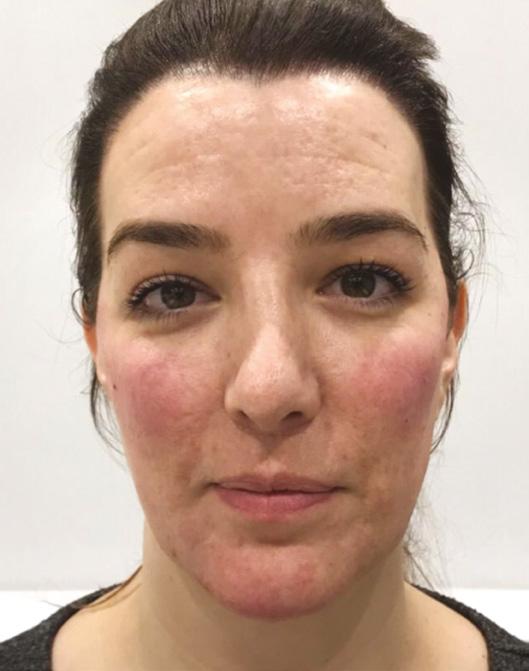
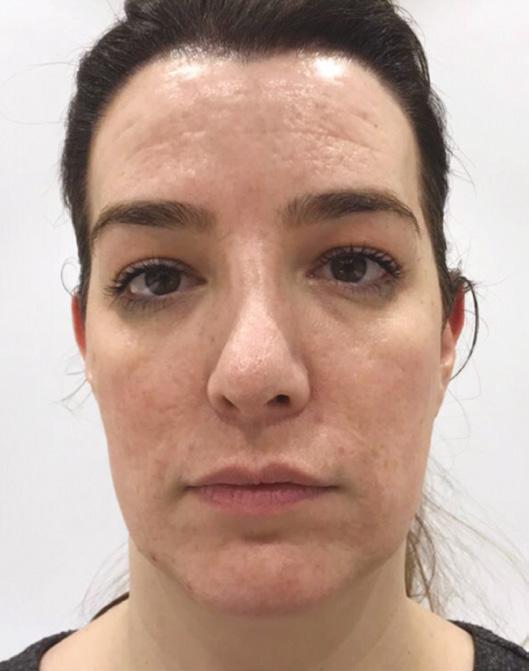
The use of botulinum toxin can assist in temporarily reducing muscle activity in the masseter muscle, thus reducing muscle mass, with the aesthetic outcome of creating a more slender angle of the mandible. Dosing can range from 20-40 units per side, though higher doses in general are associated with a greater incidence of complications.13,26 A physiological consideration when treating men is that they tend to have a greater number of microvessels present, coupled with a dense vascular plexus to support hair follicles that product thicker facial hair.11 As a result, men are more prone to bruising after facial injections. Although no one single injection protocol can be applied to each individual sex, it is widely accepted that due to the presence of larger facial muscles, men require higher doses of botulinum toxin injections to create the same cosmetic effect as in women. In any case, a dynamic assessment of each individual patient should be made to determine potential areas of stronger contraction that may be indicated by deeper lines, larger visible and palpable muscle mass and greater dynamic movement.12
Conclusion While this article has discussed the typical dimorphic approaches to the treatment of the lower facial third in the male and female, sensitive consideration should be made to the fact that society in general and young people in particular are increasingly challenging conventional gender stereotypes. The subject of gender has become a topical source of interest and debate as societal interpretation of gender and its implications on the identity of an individual are continuing to shift and evolve. As with any non-surgical aesthetic treatment, a thorough consultation, systematic assessment of soft and hard tissues and their functional behaviour is essential to understanding the individual’s treatment goals and achieving outcomes that support and enhance the patient’s sense of self including that of gender identity.
Dr Eleanor Reid is an aesthetic practitioner and dental surgeon graduating from Newcastle University. Dr Reid has a background in maxillofacial surgery, hospital and practice based dentistry and is lead trainer in Newcastleupon-Tyne for Acquisition Aesthetics and director of Paragon Aesthetics.
Miss Lara Watson is dual qualified in medicine and dentistry and is currently on the only maxillofacial surgery themed core training pathway in London. Dr Watson is a faculty member for Galderma and is also a co-founding director of Acquisition Aesthetics, a training academy committed to raising the bar for standards of practice in aesthetic medicine.
Miss Priyanka Chadha currently works as a plastic surgery registrar in London and is co-director of Acquisition Aesthetics training academy. Her academic CV comprises national and international prizes and presentations, as well as higher degrees in surgical education and training. Dr Chadha is a faculty member for Galderma.
REFERENCES
1. Mauricio de Maio, Ethnic and Gender Considerations in the Use of Facial Injectables: Male
Patients, Plast Reconstr Surg. 2015 Nov;136(5 Suppl):40S-43S. 2. Cetto R. Male chin and jawline Ageing. Aesthetics Journal 2019 31-33. <https://aestheticsjournal. com/feature/male-chin-and-jawline-ageing> 3. Farhad B A Naini, Daljit S Gill, Facial Aesthetics:2.Clincal Assessment. Dental Update 2008; 35:159-170. 4. Isabela T. Wieczorek, Brian P. Hibler, and Anthony M. Rossi, Injectable Cosmetic Procedures for the Male Patient, Journal of Drugs in Dermatology, September 2015, Volume 14, Issue 9. 5. J Leversha et al. 2016 ‘Age and gender correlation of gonial angle, ramus height and bigonial width in dentate subjects in a dental school in Far North Queensland’, J Clin Exp Dent. 2016 Feb; 8(1) e49-e54. 6. Rahrovan, F. Fanian, P. Mehryan, et al., Male versus female skin: What dermatologists and cosmeticians should know, Int J Womens Dermatol. 2018 Sep; 4(3): 122–130. 7. Dr Uma Jeyanathan, What men want. Eshtetics Dentistry Today, vol 11, no3, June 2017, pp. 36-37. 8. Joshua A. Farhadian, Bradley S. Bloom, and Jeremy A. Brauera, Male Aesthetics: A Review of
Facial Anatomy and Pertinent Clinical Implications, Journal of Drugs in Dermatology, September 2015 Volume 14, Issue 9. 9. Grace K, Kim DO, Brent D. Post-adolescent Acne in Women: more common and more clinical considerations. Journal of Drugs and Dermatology. 2012(11) 708-713 10. Cunliffe WJ, Gould DJ. Prevalence of facial acne vulgarise in late adolescence and in adults.
British Medical Journal, 1979 (1) 1109-1110. 11. Joshua A. Farhadian, Bradley S. Bloom, and Jeremy A. Brauera, Male Aesthetics: A Review of
Facial Anatomy and Pertinent Clinical Implications, Journal of Drugs in Dermatology, September 2015 Volume 14, Issue 9. 12. Anido J et al. Tailored botulinum toxin type A injections in aesthetic medicine: consensus panel recommendations for treating the forehead based on individual facial anatomy and muscle tone.
Clin Cosmet Investif Dermatol 2017 10 413-421. 13. Jaff, S. Culbard, A. The Use of Boutlinum Toxin Type A in the Hypertrophic Masster Mucscle.
Aesthetic Dentistry Today, 2017. Pp.33-35. 14. Tsukahara K, Hotta M, Osanai O, Kawada H, Kitahara T, Takema, Y. Gender-dependent differences in degree of facial wrinkles. Skin Res Technol. 2013 Feb;19(1):e65-71. 15. Doual JM, Ferri J, Laude M. The influence of senescence on craniofacial and cervical morphology in humans. Sure Radio Anat 1997 (19) 175-183. 16. Harman SM, Metter EJ, Tobin JD, Pearson J Blacman MR. Longitudinal effects of ageing on serum total and free testosterone levels in healthy mean. Baltimore Longitudinal Studying of
Aging. J Clin Endocrinol Metab 2001 86 (2) 724-31 17. Wysong A, Kim D, Joseph T, MacFarlane DF, Tang JY, Gladstone HB. Qualifying soft tissue loss in the aging male face using resonance Imaging, Dermal Surgery 2014 40 (7) 783-93. 18. Bryan Mendelson & Chin-Ho Wong, Changes in the Facial Skeleton with aging: Implications and clinical application in Facial Rejuvenation. Aesthetic Plastic Surgery 2012 36: 753 760 19. Swift A, Remington K. BeautiPHIcatiion: A global approach to facial beauty. Clin Plastic Surg 38 2011 347-377 20. Jack D Contouring the Male Jawline. Aesthetics Journal, 2017 43-45. <https://aestheticsjournal. com/feature/contouring-the-male-jawline> 21. New Global Research From Allergan Shows New Attitude To Beauty As Women Seek
Confidence Over Youth, Jun 28, 2016. <https://www.newswire.ca/news-releases/new-globalresearch-from-allergan-shows-new-attitude-to-beauty-as-women-seek-confidence-overyouth-584655091.html> 22. Sobanko JF et al., Motivations for Seeking Minimally Invasive Cosmetic Procedures in an
Academic Outpatient Setting, Aesthet Surg J. 2015 Nov;35(8):1014-20. 23. Maio M., Wu W.T.L., Goodman G.J., Monheit G. (2017). Facial Assessment and Injection Guide for
Botulinum Toxin and Injectable Hyaluronic Acid Filler: Focus on the Lower Face. Plast. reconstr.
Sur. 140: 393-404 24. Sundaram, H. and D.Cassuto, Biophysical characteristics of hyaluronic acid soft-tissues fillers and their relevance to aesthetic applications. Plastic and reconstructive surgery, 2013. 132(4s-2): p. 5s-21s. 25. Wang Q et al., Vascular Complications after chin augmentation using Hyaluronic acid. Aesth Last
Surg 2018 42 553-59. 26. Chang, C-S. Kang, G. Achieving Ideal Lower Face Aesthetic Contours: Combination of
Tridemensional Fat Grafting to the Chin with Master Boutlinum Toxin Injection. Aesthetic Surgery
Journal (2016), p1093-1100.
The secret to full facial rejuvenation
Dr Kuldeep Minocha, Aesthetic Practitioner
DR KULDEEP MINOCHA
Do you have any tips for practitioners looking to treat the whole face?
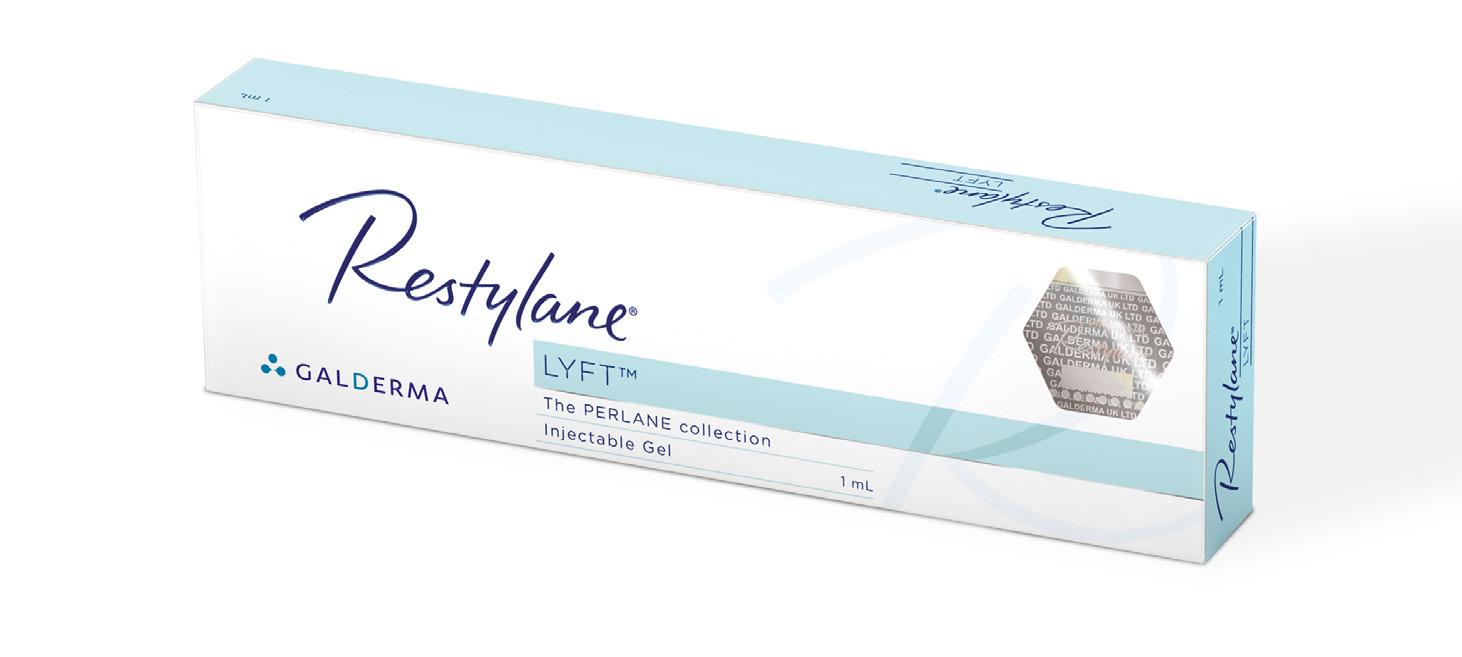
Each time you see a patient, look at them with fresh eyes. Take the time to look at how the light is hitting the face and where the shadows are.
Which dermal fillers do you prefer?
I only ever use the Restylane® range. I’ve used Restylane® in over 30,000 treatments over twelve years. My reputation depends on using products I know and trust. There are eight fillers in the range and each one varies slightly in consistency, particle size and lift capacity. I like having a broad artistic palette to choose from and it means I can tailor the treatment for each patient.
What do you look for when assessing the face?
• Skin quality – assess skin hydration, sun damage, fine lines and wrinkles • Facial shape and balance – is there too much weight in the lower third and can we recreate the heart-shaped or oval-shaped face? • Proportions and contours – look at the frontal view, the profile view and the three-quarter view and assess the relationships between each subunit of the face • Facial symmetry – are the features balanced and how do they change when animated? • Emotion – does the face look sad, angry or tired and which areas are contributing to these emotions?
A patient treated with Restylane Lyft™ , Restylane Refyne™ , Restylane Volyme™ and Restylane Defyne™
What products do you use for different parts of the face?
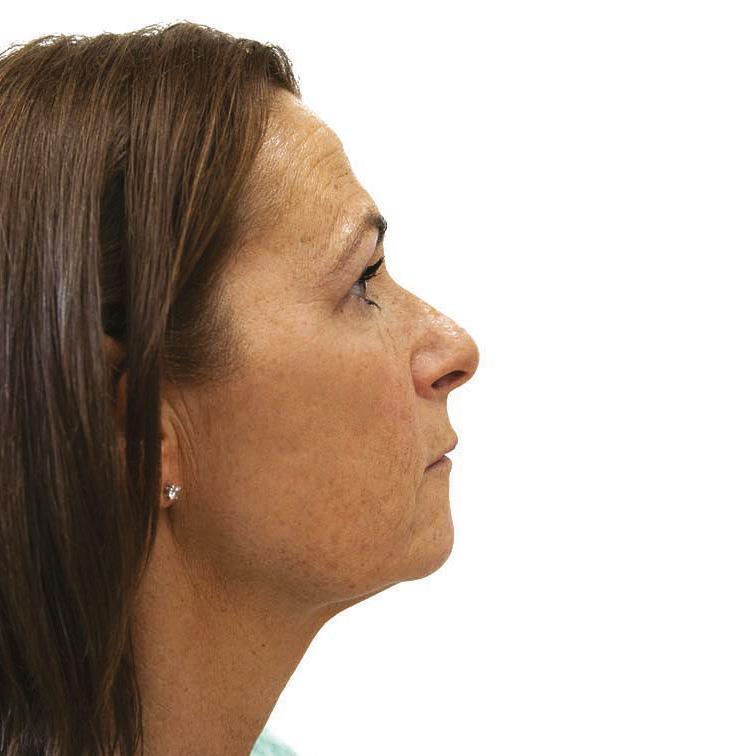
If I’m looking to fill a large area I use Restylane Volyme™, say for the temple or the sub-malar area. If I’m injecting more superficially I’d go for Restylane Refyne™ which has a smaller particle size and integrates nicely into the skin. Where I want definition and projection on the cheeks, nose, jaw or chin, I use Restylane Lyft™. If I’m reconstructing or restoring the lips I’ll use Restylane™, but if I’m looking to volumise, beautify and enhance the lip I’d use Restylane Kysse™ which is softer and integrates well.
If you could only choose one product what would you choose?
That’s easy. My go-to product would always be Restylane Lyft™. The high G-prime, precision and lift means you can get a impressive result with only one or two syringes. It’s really effective for countering the reabsorption of the bone and the descent of the fat pads that happens to all of us as we age. Not everyone can afford multiple syringes and I find more and more people want the biggest bang for their buck. With Restylane Lyft™ you get that.
About Dr Minocha
Dr Kuldeep Minocha qualified as a GP in 1996. After working for the NHS as GP principal in Essex for a number of years, he commenced training and practice in facial aesthetics in 2006. Dr Minocha founded Minocha Health, his aesthetic practice, the same year, before concluding his NHS commitments in 2011 to take up a full-time career in aesthetics. Dr Minocha is a global brand ambassador and key opinion leader for Galderma.








